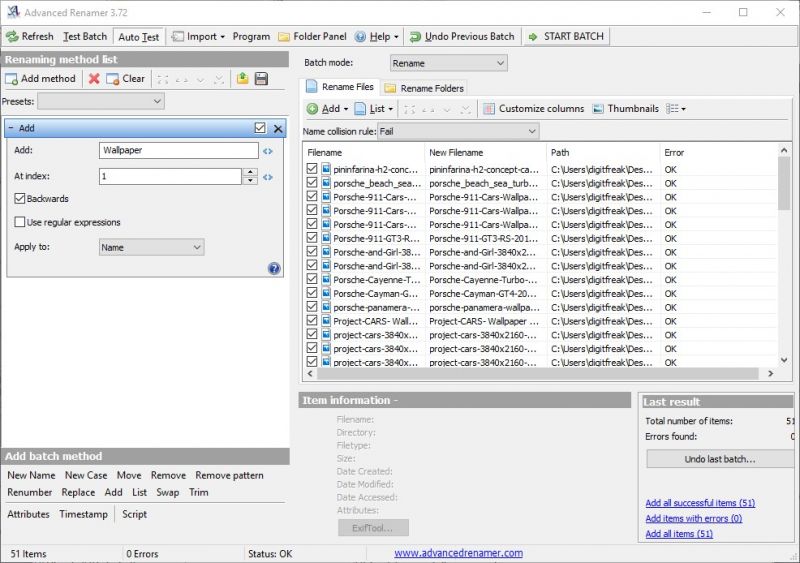
- OSX RENAME MULTIPLE FILES HOW TO
- OSX RENAME MULTIPLE FILES INSTALL
- OSX RENAME MULTIPLE FILES SERIES
- OSX RENAME MULTIPLE FILES DOWNLOAD
- OSX RENAME MULTIPLE FILES MAC
cpp will only occur once, at the end of the name, but in the general case you have to be careful when formulating the command. In this case, where the task is to change the file suffix, this is unlikely to be a problem because. However, for lack of RegEx-Style anchors this will replace the first occurence of the original pattern with the substitution. If you don't have the Perl version of rename, but the util-linux variant, the corresponding command would be rename ".cpp" ".java" a.cpp The task you describe can be done entirely without xargs using exactly that rename command by using shell syntax features, as in: rename 's/cpp$/java/' a.cpp I don't know if that can be called an "efficient way" to use xargs, but from your comment I take it that you want to explore xargs possibilities, and this is a reasonably reliable way to do it. Then, xargs with the corresponding -0 option is used to invoke the (external) rename tool to which you can supply a sed style name transformation command (note that this assumes the Perl-based rename tool, not the util-linux variant, as noted by - see here for a discussion). This will use find to generate the list of relevant files according to your requirement, and output them as NULL-terminated string to ensure that filenames with spaces etc. type f -name 'a.cpp' -print0 | xargs -0 rename 's/cpp$/java/' That said, and assuming you have the GNU version of find and xargs with the -print0 and -0 options, the following will do: find. Now simply type the identifying text you want to replace into the Find field, and enter the text you want to replace it with in the Replace With field, then click Rename.As always when using xargs with filenames, you must be careful if your filenames contain non-trivial characters. Select all the files in a folder (make sure they're all of the same kind, or this won't work), bring up the Rename Finder Items panel in the same way as before, but this time select Replace Text in the first dropdown. This is particularly convenient if you have tens or hundreds of files in a folder with different names and you only want to change those files that contain a particular word.
OSX RENAME MULTIPLE FILES HOW TO
How to Search and Replace Text in File Namesįinder also allows you to rename only certain files whose names include a certain piece of identifying text. Then just type in the additional text in the input field. Simply select the files whose names you want to adjust and bring up the Rename Finder Items panel as described above, only select Add Text from the from the first dropdown instead. How to Add Text to Existing File Namesįinder's renaming tool also lets you add supplementary text to filenames without changing their original titles. Note that if you're note happy with the change, you can select Edit -> Undo Rename in the Finder menu bar or press the keys Command-Z to revert the files back to their original names.

The selected files will now be renamed with your chosen nomenclature. Make sure you're happy with the preview example at the bottom of the Rename panel, then click Rename.Note that if you selected a number format, you can use the Where dropdown to choose whether the sequential numbers appear before or after the common name of your files.
OSX RENAME MULTIPLE FILES SERIES

For example, to change a search string in all filenames in current directory: rename -nvs searchword replaceword.
OSX RENAME MULTIPLE FILES INSTALL
We're going to use Name and Index, but you can optionally select Name and Counter or Name and Date. To rename files, you can use the rename utility: brew install rename.

In the next dropdown, select a Name format.Select Format from the first dropdown menu in the Rename Finder Items panel.Alternatively, right-click (or Ctrl-click) one of the selected files in the Finder window. Click the Action button in the Finder toolbar.Drag a selection box over the files with your mouse or hold the Shift key and click them one by one.Open a Finder window and locate the files you want to rename.In our example we're going to be batch renaming some photos.
OSX RENAME MULTIPLE FILES MAC
To rename several files of the same kind on your Mac at once, follow the steps below. Since OS X Yosemite however, Apple has integrated several useful batch renaming capabilities directly into Finder.
OSX RENAME MULTIPLE FILES DOWNLOAD
In early versions of Mac OS, users looking for a way to quickly rename multiple files simultaneously (commonly referred to as batch renaming) had to use the command line or download and install a third-party tool dedicated to the task.


 0 kommentar(er)
0 kommentar(er)
